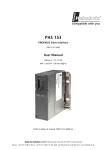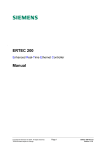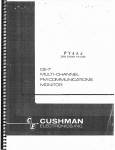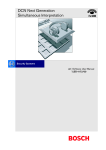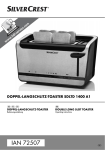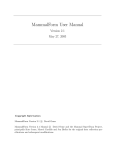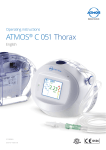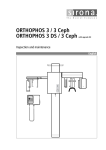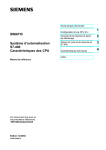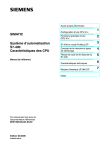Download Pro Mariner True Power 400PS Series Specifications
Transcript
Product Brief · January 2003 The most powerful PLC Introduction The S7-400® is the most powerful PLC in the SIMATIC® Controller family; the range that enables successful automation solutions with Totally Integrated Automation. The S7-400 is an automation platform for system solutions in the manufacturing and process industries, and is distinguished above all by its modularity and performance reserves. Areas of application Application areas are found in · the automobile industry (e.g. production lines) · mechanical engineering, including specialist machine construction · warehousing · building systems automation · the steel industry · energy generation and energy distribution · the paper and printing industry · woodworking · the food and beverages industry · process engineering, e.g. water supply and disposal · the chemical and petrochemical industries Specialist applications There are other versions of the S7-400 available for specialist applications: · Applications requiring fault tolerance can be implemented with the S7-400H · For failsafe applications, there is the S7-400F that is also available in a fault-tolerant version · S7-400 CPUs are available as PC plug-in cards for PC-based solutions Storage of all project data, including symbols and comments, on the CPU makes service and maintenance work palpably easier. In addition, powerful integrated system diagnostics functions guarantee increased availability of the controller and therefore greater productivity. To this are added configurable process diagnostics functions for analysis of process faults in order to reduce downtimes and further boost productivity. PS SM CPU Configuration of the S7-400 2 An S7-400 system consists basically of a backplane, a power supply, and a CPU. The system is modular and can be set up easily without the need to observe slot rules. The S7-400 is characterized by rugged fan-free operation with hot swapping of signal modules. A diverse range of modules can be used both for centralized expansions and for easy setup of distributed structures with the ET 200®; this results in extremely low-cost spare parts inventory. Modularity Engineering and diagnostics In conjunction with the SIMATIC Engineering Tools, the S7-400 results in extremely efficient configuring and programming, particularly in extensive automation solutions with a high proportion of engineering. Examples include high-level languages like SCL and graphical Engineering Tools for sequential controls, state diagrams and technology-oriented diagrams. Installation CP Modularity is an outstanding feature of the S7-400. The powerful backplane bus of the S7-400, and the communications interfaces that can be connected direct to the CPU, allow high-performance operation of a large number of communications lines. This makes it possible, for example, to break up the system into a line for HMI and programming tasks, one for high-performance and equidistant motion control components, and one for the "normal" I/O field bus. Additionally required connections to MES/ERP systems or to the Internet can also be implemented. CPU performance There is a graded range of CPUs available for controller design, from the entry-level CPU right up to the high-performance CPU. All CPUs have large quantity structures, and several CPUs can work together in multicomputing configurations in order to boost performance. The CPUs enable short machine cycle times, thanks to their efficient processing speed and deterministic response times. Memory in MB 4.0 3.2 1.6 0.75 Range of CPUs All the CPUs have a combined programming and PROFIBUS DP interface. This means they can be accessed at any time from the OP or programming device/PC or networked with various controllers. This interface can also be used for connecting distributed PROFIBUS DP devices. This means that all the CPUs can be operated directly with distributed I/O. All the CPUs, except the entry level CPU 412-1, also incorporate a PROFIBUS DP interface whose main function is to act as the interface to distributed I/O, but which can also be configured to be used for communications with the OP or programming device/PC. The higher-end CPUs also have free slots for PROFIBUS DP interface modules in order to connect additional DP lines. Otherwise, the only difference between the CPUs is the performance scope, e.g. RAM, address range, number of modules which can be connected and processing time. Multi-computing Multi-computing, i.e. running more than one CPU in a S7-400 central controller, has a number of benefits to the user. · Multi-computing means that the overall performance of an S7-400 can be split up. For example, complex technical functions, such as controlling, computing or communicating, can be separated and assigned to different CPUs. And each CPU can be assigned its own, local I/O. · Multi-computing also enables different functions to be separated from one another, so, for example, one CPU can process the time- critical processing functions and another CPU the non-time critical functions. Binary instruction processing time in Ns 0.25 Number of blocks in K 0.1 16 8 3 1 0.2 0.1 0.08 4 8 16 Address range in KB Range of S7-400 CPUs In multi-computing mode, all the CPUs together act as a single CPU, i.e. if one CPU goes into STOP mode, all the other CPUs stop at the same time. Synchronization calls enable the actions of multiple CPUs to be coordinated for each individual instruction. At the same time, data transfer between the CPUs is extremely fast thanks to the “Global Data” mechanism. Performance The S7-400 stands out not only for its short response times, but also for its large performance reserves. Very short response times can be attained, even when simultaneous communication is required, or other unforeseeable loads occur. This, in turn, makes it possible to obtain specific response times, e.g. the response of an output signal to a change in input signal. Diagnostics The CPUs’ intelligent diagnostics system continuously monitors the functionality of the system and the process, and registers errors and specific system events (CPU black-box); there is also the option of adding extra diagnostic messages. The diagnostics function can determine whether the signal logging (for digital modules) or analog processing (analog modules) functions of the module are in good working order. In the event of a diagnostics message (e.g. “no supply to encoder”), the module triggers a diagnostics interrupt The CPU then interrupts the processing of the user program and executes the appropriate diagnostics interrupt block. Process interrupts mean that process signals can be monitored and reactions to signal changes can be triggered. 3 Integrated interfaces On the other hand, following integration of the DP V1 functions according to IEC 1158 Parts 3-6, new, standardized PROFIBUS DP functions are now also available in the S7-400 for communication with non-Siemens systems. In automation, there is a trend towards distributed systems. The SIMATIC S7-400 supports the required data exchange between distributed systems. Interfaces integrated directly into the CPUs mean you can set up a high-performance communications environment using conventional bus technology. Furthermore, the operating parameters of field devices can be modified during operation, thus reducing conversion times. Finally, expanded diagnostics functions facilitate troubleshooting and help reduce down times. The programming interface All CPUs have a combined programming and PROFIBUS DP interface which can be accessed at any time by up to 125 programming devices/PCs or OPs and can also be networked with other controllers. This interface can also be used for connecting up to 31 distributed PROFIBUS DP devices. · By means of data communication, this interface enables the transfer of process data between various different controllers, e.g. one CPU can access the inputs or outputs of another CPU. · The programming interface also has all the functionality of a DP interface. Communications interface modules Communications interface modules can be used optionally in the S7-400 CPUs in order to adapt them to the requirements of the application in hand. The CPUs 414-3 and 416-3 have one free slot, and the CPU 417-4 has two free slots for this purpose. By connecting such interface modules, additional DP lines can be established as master or slave whose functionality corresponds to that of the integral interface. Shared functions CPU 417-4 with integrated interfaces PROFIBUS DP interface (or “centralized = distributed”) In terms of configuration and programming, there is no difference between centralized and distributed I/O. To make setting up relatively large distributed structures economically viable, the SIMATIC S7-400 can be connected as a master to the PROFIBUS DP open field bus (in accordance with EN 50170). This allows communications with a number of partners, from the SIMATIC controller to field devices from other manufacturers. Up to 125 stations can be controlled by one DP interface. More than 400 PROFIBUS slaves can be connected to a CPU with 4 interfaces; this means an S7-400 station can drive more than 1600 PROFIBUS slaves. Firmware release V 3.0 and later (from July 2001) provides the S7-400 with even more networking functionalities. On the one hand, the S7-400 can now also be used as an intelligent slave on PROFIBUS DP, permitting intelligent, distributed preprocessing. 4 PG functions, e.g. programming by programming device/PC over long distances, are possible using either interface type. A programming device (PG) can also operate more than one CPU, or more than one programming device can access a CPU. There is also a routing function whereby a programming device connected to any point in the network can access all the stations on the network. HMI functions are already integrated into the operating system of the S7-400 and transfer data to connected SIMATIC Operator Panels or Operator Stations without the need for any programming. As with the PG functions, the control and monitoring functions are compatible with either the programming or the DP interface. For all panels in the SIMATIC HMI range, the configuration software used is SIMATIC ProTool/Pro® - a consistent, uniform, Windows-based system which accesses the STEP 7 database and thus avoids duplicate entries. More advanced functions, e.g. connection to bus systems, can be achieved using communications modules. Memory concept, isochrone mode, configuration changes in RUN (CiR) Memory concept All S7-400 CPUs have two types of memory: load memory and main memory. This splitting of the main memory improves performance by around 100 %. While a standard processor accesses its RAM memory at least twice, the special S7-400 processor accesses the code memory and the data memory simultaneously in a single cycle. This is made possible by the separate code and data bus. This is direct performance which is of benefit to the customer! The size of the main memory is determined by selecting the appropriate CPU from the finely graded range of CPUs. In the CPU 417, the main memory can be expanded to up to 20 MB by slotting in extra memory modules. The integrated memory (RAM) is adequate for small to medium-sized programs. For larger programs, the memory can be increased by slotting in extra RAM. Additional plug-in flash memory cards are available to enable retentive memory without the use of a battery. Isochrone mode: Securely handles fast processes Isochrone mode External load memory battery-backed RAM or retentive Flash Memory · Integrated load memory battery-backed RAM Load memory for project data (blocks, symbols, comments, configuration, parameterization data, etc.) customer files · · · Main memory, code 50 % for program non-backed RAM · · Main memory, data 50 % for data battery-backed RAM Main memory for processrelated modules, process image, local data · · · Memory types for the SIMATIC S7-400 The S7-400, as the most powerful PLC in the SIMATIC controller family, offers important new system functions when used with the new operating system 3.1 and in conjunction with other TIA components: The S7-400 is now capable of providing distributed I/O solutions with the capability to handle extremely fast processes with very high precision. Consequently, production can be enhanced while at the same time increasing quality. This was made possible by the new system function denoted „isochrone mode“. Isochrone mode means that the distributed I/O devices obtain signal inputs and outputs synchronously through the equidistant PROFIBUS and forward these signals for synchronous processing in the PLC. This way, all input signals are read, processed synchronously, and in concert with the output signals. Process response times are therefore reproducible and defined, and you can be assured that the distributed I/O system will process signals synchronously and at the same time. The precise reproducibility of all processes, even very fast ones, is no longer a problem. Many components now support isochrone mode, enabling the user to handle many applications in the area of motion control, measurement technology and loop control. Hardware configuration changes in RUN (Configuration in RUN, CiR) Another new feature is that SIMATIC S7-400 now allows hardware reconfigurations without any adverse effects while in run mode, e.g. to implement new sensors or actuators. CiR - Configuration in RUN - reduces time needed for commissioning and retrofit because these changes can now be undertaken while the plant is in full operation. Also, this new system function makes it possible for technicians to respond to process changes and implement process optimizations very easily since the plant must not be re-initialized and synchronized when hardware is changed. It is possible to add and remove distributed I/O stations (PROFIBUS DP and PROFIBUS PA slaves), to add and remove individual I/O modules in the I/O system ET 200M, and to assign new parameters (e.g. to select other interrupt thresholds). 5 S7-400H fault tolerant PLC Based on standard S7-400 modules, the S7-400H is a fault tolerant (redundant) PLC which drastically reduces the risk of production downtime. Its fault tolerant structure makes the S7-400H ideally suited to applications in which MTTR and downtimes need to be reduced or avoided where possible, e.g. for energy generation / distribution, the chemical industry, mining, transport, etc. The fault tolerance is achieved by means of two parallel central controllers whose CPUs are connected by means of fiber optic conductors and which control the I/O through redundant PROFIBUS DP lines. Redundant I/O is presently under development. Once this is available, it will be possible to compensate failing I/O in addition to failing CPU and PROFIBUS. In the event of an error, there is a bumpless transfer of control, i.e. the intact standby device takes over execution at the point of interruption, with no loss of information. When setting up a fault-tolerant S7-400H controller, the user can concentrate entirely on the job in hand: · The S7-400H is programmed in the same way as a non-redundant standard S7-400 system using any STEP 7 language. All redundancy-specific functions can be configured using a easy-to-use STEP 7 option package. A program written for a standard non-redundant system can easily be ported to a redundant system (and vice versa). · The S7-400H consists almost exclusively of standard components from the SIMATIC S7 range and is an integral part of Totally Integrated Automation® (TIA). Further information can be found in the Product Brief “SIMATIC S7-400H and S7-400F/FH - Top end controllers with fault tolerant and fail-safe functionalities”. SIMATIC S7-400H fault tolerant PLC SIMATIC S7-400H I/O station with redundant interface Y link PA link Configuration of SIMATIC S7-400H with in-circuit connection of I/O 6 S7-400F/FH fail-safe PLC The new SIMATIC S7-400F/FH is an addition to the range of SIMATIC S7 controllers. It is a fail-safe controller based on the technology of the fault tolerant S7-400H. The SIMATIC S7-400F/FH enters a safe state immediately when an error occurs or remains in a safe mode, thus guaranteeing a high level of safety for man, machine, the environment and the process. The S7-400F/FH has a TÜV approval (TÜV = German Technical Inspectorship) and fulfills all relevant standards. The S7-400F/FH can also be used as a standard or fault tolerant controller. This means that the SIMATIC S7-400F/FH combines standard automation functions and safety-related technology in a single system. The CPUs of the SIMATIC S7-400F/FH are based on the CPUs of the SIMATIC S7-400H system (CPU 414-4H, 417-4H), with the addition of what is known as an F-library. This F-library contains pre-assembled, TÜV-approved basic function blocks as well as a parameterization tool for the fail-safe I/O modules. The CFC Engineering Tool is used to call blocks from the F-library and interconnect them, i.e. there is no additional familiarization time for the programming. These ET200®M fail-safe I/O modules are connected to PROFIBUS and controlled by means of the new PROFISafe PROFIBUS profile for safety-related applications. There is also an additional advantage in the fact that a S7-400F/FH fail-safe controller largely consists of standard components and is an integral part of Totally Integrated Automation (TIA). This means the S7-400F/FH can now be used for areas of automation which, up to a few years ago, were the exclusive domain of conventional electro-mechanical controllers, e.g. automobile shell construction using presses and robots, burner management systems, transportation of persons on cableways and, last but not least, process automation. Further information can be found in the Product Brief “SIMATIC S7-400H and S7-400F/FH - Top end controllers with fault tolerant and fail-safe functionalities”. SIMATIC S7-400F/FH fail-safe PLC F-compatible S7-400H CPU (CPU 417-4H) Standard SMs F-SMs (DI, DO, AI) Standard PROFIBUS DP connection of I/Os with additional fail-safe DP communication (PROFIsafe) 7 CPUs - Technical specifications CPU 412-1 CPU 412-2 CPU 414-2 CPU 414-3 Main memory integrated in instructions for program for data · · · · 96 Kbyte 32 K 48 Kbyte 48 Kbyte 144 Kbyte 32 K 72 Kbyte 72 Kbyte 256 Kbyte 84 K 128 Kbyte 128 Kbyte 768 Kbyte 84 K 384 Kbyte 384 Kbyte Load memory integrated expandable to · · 256 Kbyte RAM 64 Kbyte 256 Kbyte RAM 64 Kbyte 256 Kbyte RAM 64 Kbyte 256 Kbyte RAM 64 Kbyte Backup Yes Yes Yes Yes Number of blocks FB FC DB · · · 256 256 511 (DB 0 reserved) 256 256 511 (DB 0 reserved) 2048 2048 4095 (DB 0 reserved) 2048 2048 4095 (DB 0 reserved) Program execution free cycle timed interrupts delay interrupts time interrupts process interrupts multi-computing interrupt startup · · · · · · · 1 2 2 2 2 1 3 1 2 2 2 2 1 3 1 4 4 4 4 1 3 1 4 4 4 4 1 3 Execution times bit operations word operations fixed point arithmetic floating point arithmetic · · · · 2 µs 2 µs 2 µs 3 µs 2 µs 2 µs 2 µs 3 µs 0.1 µs 0.1 µs 0.1 µs 0.6 µs 0.1 µs 0.1 µs 0.1 µs 0.6 µs Bit memories/timers/counters Bit memories S7 timers/S7 counters IEC timers/IEC counters 4 Kbyte 256/256 SFB/SFB 4 Kbyte 256/256 SFB/SFB 8 Kbyte 256/256 SFB/SFB 8 Kbyte 256/256 SFB/SFB 21 max. 10 limited by number of slots and number of connections limited by number of slots and number of connections 21 max. 10 limited by number of slots and number of connections limited by number of slots and number of connections 21 max. 10 limited by number of slots and number of connections limited by number of slots and number of connections 21 max. 10 limited by number of slots and number of connections limited by number of slots and number of connections Programming interface Number of stations Transmission speed · · 16 max. 12 Mbit/s 16 max. 12 Mbit/s 32 max. 12 Mbit/s 32 max. 12 Mbit/s DP interface Number of stations Transmission speed · · 32 max. 12 Mbit/s 32 + 64 max. 12 Mbit/s 32 + 96 max. 12 Mbit/s 32 + 2 x 96 max. 12 Mbit/s Address ranges Total I/O address area I/O process image Total digital channels Total analog channels · · · · 4 Kbyte /4 Kbyte 4 Kbyte /4 Kbyte 32768/32768 2048/2048 4 Kbyte /4 Kbyte 4 Kbyte /4 Kbyte 32768/32768 2048/2048 8 Kbyte /8 Kbyte 8 Kbyte /8 Kbyte 65536/65536 4096/4096 8 Kbyte /8 Kbyte 8 Kbyte /8 Kbyte 65536/65536 4096/4096 MLFB group 6ES7412-1XF... 6ES7412-2XG... 6ES7414-2XG... 6ES7414-3XJ... · · · Design Number of expansion units Number of DP masters, through CP Number of FMs · · · · 8 Number of CPs CPUs - Technical specifications CPU 416-2 CPU 416-3 CPU 417-4 Main memory integrated in instructions for program for data · · · · 1.6 Mbyte 530 K 0.8 Mbyte 0.8 Mbyte 3.2 Mbyte 1065 K 1.6 Mbyte 1.6 Mbyte 4 Mbyte 1335 K 2 Mbyte 2 Mbyte Load memory integrated expandable to · · 256 Kbyte RAM 64 Kbyte 256 Kbyte RAM 64 Kbyte 256 Kbyte RAM 64 Kbyte Backup Yes Yes Yes Number of blocks FB FC DB · · · 2048 2048 4095 (DB 0 reserved) 2048 2048 4095 (DB 0 reserved) 6144 6144 8191 (DB 0 reserved) Program execution free cycle timed interrupts delay interrupts time interrupts process interrupts multi-computing interrupt startup · · · · · · · 1 8 4 9 8 1 3 1 8 4 9 8 1 3 1 8 4 9 8 1 3 Execution times bit operations word operations fixed point arithmetic floating point arithmetic · · · · 0.08 µs 0.08 µs 0.08 µs 0.48 µs 0.08 µs 0.08 µs 0.08 µs 0.48 µs 0.1 µs 0.1 µs 0.1 µs 0.6 µs Bit memories/timers/counters Bit memories S7 timers/S7 counters IEC timers/IEC counters 16 Kbyte 512/512 SFB/SFB 16 Kbyte 512/512 SFB/SFB 16 Kbyte 512/512 SFB/SFB 21 max. 10 limited by number of slots and number of connections limited by number of slots and number of connections 21 max. 10 limited by number of slots and number of connections limited by number of slots and number of connections 21 max. 10 limited by number of slots and number of connections limited by number of slots and number of connections Programming interface Number of stations Transmission speed · · 64 max. 12 Mbit/s 64 max. 12 Mbit/s 64 max. 12 Mbit/s DP interface Number of stations Transmission speed · · 32 + 125 max. 12 Mbit/s 32 2 x 125 max. 12 Mbit/s 32 + 3 x 125 max. 12 Mbit/s Address ranges Total I/O address area I/O process image Total digital channels Total analog channels · · · · 16 Kbyte /16 Kbyte 16 Kbyte /16 Kbyte 131072/131072 8192/8192 16 Kbyte /16 Kbyte 16 Kbyte /16 Kbyte 131072/131072 8192/8192 16 Kbyte /16 Kbyte 16 Kbyte /16 Kbyte 131072/131072 8192/8192 MLFB group 6ES7416-2XK.. 6ES7416-3XL... 6ES7417-4XL... · · · Design Number of expansion units Number of DP masters, through CP Number of FMs · · · · Number of CPs 9 Programming The configuration and programming of the S7-400 is based on STEP® 7. STEP 7 offers functions for every phase of an automation project – from configuration to startup, testing and servicing. Memory requirement STEP 7 STEP 7 incorporates the SIMATIC Manager, the central tool for the software-related handling of the project. This relates not only to a single CPU, but to the whole plant – irrespective of how many controllers, drives and HMI devices the solution consists of. Using STEP 7 also ensures that the data is kept consistent throughout the project. STEP 7 incorporates both the hardware configuration of the plant and the parameterization of the modules, so there are no more hardware settings to be made. STEP 7 also includes the three basic languages: statement list (STL), ladder diagram (LAD) and function block diagram (FBD). STEP 7 also makes it possible to parameterize high-speed data communications between networked CPUs. Engineering Tools As the S7-400 is generally used for executing large programs, there are also higher-level languages and graphical engineering tools based on STEP 7. These have the additional functionality to enable you to program automation solutions in a function-oriented manner and using a user-friendly interface. Productivity Memory required for engineering tools The following tools are available for programming: S7-SCL (Structured Control Language), PASCAL-based higher-level language for programming SIMATIC S7/C7 controllers S7-GRAPH enables graphical configuration of sequential control systems for SIMATIC S7/C7 S7-HiGraph® for graphical description of sequential or asynchronous process with status diagrams for SIMATIC S7/C7 CFC (Continuous Function Chart), the technology-oriented diagram which enables graphical interconnection of complex functions for SIMATIC S7 10 Data storage The new STEP 7 Version 5.1 allows any data to be saved to the CPU, i.e. if you are servicing or upgrading the system, the personnel can still access not only the programs running, but also the whole project, including any comments and symbols. If you are using higher-level languages or graphical engineering tools, the program source code is also immediately available in its original form or in graphical format. Last but not least, it is also possible to save customer-specific operating instructions, manuals and machine documentation directly on the CPU in all standard file formats. Communication Totally Integrated Automation A single, completely integrated and consistent system with which you can execute any automation functions! An element of central importance within the system is the communications network: Industrial Ethernet (IEEE 802-3 and 802.3u) – the international standard for area and cell networking – with a connection to the IT environment. S7-400 S7-300® OS Data communication PROFIBUS (IEC 61158/EN 50170) – the international standard for the cell and field levels. PC OS AS-Interface (EN 50295) – the interna- tional standard for communications with sensors and actuators. EIB (EN 50090, ANSI EIA 776) – the global standard building installation system and the basis for building services automation. S7-400 Scanner Point to point connection – for commu- Network access Process or field communications Process or field communication are used to connect actuators/sensors to a CPU. Process or field communication with the S7-400 is supported by PROFIBUS DP. To make this possible, the S7-400 can be connected to PROFIBUS DP as a master – either by means of the interface integrated into each CPU, a special interface module or a communications processor (CP). The AS interface and EIB networks and other bus systems are accessible from the S7-400 through the PROFIBUS gateways. Link Link Fire alarm Data communications Data communications enable data transfer between automation systems or between an automation system and an intelligent partner (PC, computer, etc.). This is achieved either through the programming interface or by means of PROFIBUS and Industrial Ethernet. ET 200 Sensor Process/field communication nication between two stations with special protocols. The point to point structure represents the simplest form of communication. Various different special protocols are used (e.g. RK 512, 3694(R) and ASCII). Communication options for the SIMATIC S7-400 The programming interface enables simple cyclical data transfer on the one hand (no acknowledgment) and programmed transfer of relatively large volumes of data on the other (with or without acknowledgment). Specific communications processors (CP) are used for the connection to PROFIBUS and Industrial Ethernet; which means that the TCP/IP protocol can be accessed direct from the program. 11 Range of modules In addition to the range of specific S7-400 modules, the S7-400 also gives access to the world of PROFIBUS through the integrated PROFIBUS DP interface. This means that a large number of I/O modules are available with which the S7-400 can be adapted to a wide range of functions. Users of the system have access to PROFIBUS DP modules from Siemens as well as modules from other manufacturers. Naturally, there is also a wide range of S7-400 modules which can be used in central controllers and expansion units: · intelligent power supplies (redundant, diagnostics-compatible) to secure the supply of all operating voltages · digital and analog I/O modules for nearly all signal types, including some with interrupt processing and diagnostics · function modules for counting/ measurement, all types of positioning functions, cam control, motion control and computing · communications modules for serial point to point connection and bus communications by means of PROFIBUS and Industrial Ethernet · interface modules for connecting expansion units to the central controller The following documents contain additional information on the range of modules and on communications: · Product Brief „SIMATIC based Technology“ · Product Brief “Counting/Measuring with SIMATIC” · Product Brief “Positioning with SIMATIC“ · Product Brief “Loop control with SIMATIC” · Product Brief “Cam control with SIMATIC” · Product Brief “S7-300/400 point-to-point coupler modules” · Multi-Media-CD “SIMATIC Technology ... in Action” · Overview “Industrial communications for automation” · Product Brief “Unbeatable performance without limits with FM 458-1DP in S7-400“ 12 Expansion options Interface to the world of IT Not only can a S7-400 system be expanded using PROFIBUS DP, but additional racks can also be linked directly to the central processing unit. Distances of up to 600 m can be covered without any performance loss of the backplane bus. The power supply can also be looped through for shorter distances. The S7-400 allows you to integrate the modern world of IT into automation. The pluggable CP (CP 443-1 IT®) enables the following functions: · Creation of your own web pages using any HTML tools, and the process variables for the S7-400 can simply be assigned to the HTML objects · Monitoring of the S7-400 through these web pages using a standard browser · Sending of e-mails from the user program of the S7-400 by means of function calls · Remote programming through the telephone network (e.g. ISDN) using the WAN properties of TCP/IP. Racks with 18 or 9 slots are available as the central controller. Using interface modules, up to 21 expansion units, each with either 18 or 9 slots for S7-400 modules, can be connected Communication Technology Point to point connection with data rates of up to 115 Kbit/s and various protocols, e.g. for connecting modems, printers, scanners, drives, external devices, etc. Counting in various modes, up to 500 kHz Connection to PROFIBUS using either the DP or the FMS protocol (DP V0 and DP V1) Cam control for up to 16 cam lines per module Connection to Industrial Ethernet using the ISO/TCP or TCP/IP data communications protocol Any type of positioning function: controlled positioning using the rapid/creep feed process (3 axes per module) Connection to the Internet through Ethernet for loading websites and using e-mail Point to point positioning and velocity profiles (position control) with stepper and servo motors (3 axes per module) PID controller with backup functionality and integrated online self-configuration for various types of controller (continuous controllers, stepper controllers, pulse controllers) Freely programmable, highly dynamic controller for up to 100 axes per module I/O modules – Properties Selection guide for digital inputs/outputs Signal modules are the interface between the SIMATIC S7-400 and the process. A wide range of different digital and analog modules provide exactly the right inputs/outputs required for the function in question. However, the S7-400 signal modules represent only a subset of the modules which can be connected to the S7-400 through PROFIBUS DP. with individual strands and a completely modular building block system, consisting of front connector module, cable and terminal block. High level of packaging density The large number of channels on the modules is one reason for the space-saving design of the S7-400: Modules are available with 8 to 32 channels (digital) or 8 to 16 channels (analog) per module. Easy to install The sensors/actuators simply connect to the front connector. When replacing the module, all you need to do is plug the connector into the new module of the same type. You do not need to change the wiring. The coding of the front connector prevents confusing of modules. Simple to configure The modules are configured and parameterized using STEP 7, there are no fiddly switch settings. The data is stored centrally and automatically transferred to the new module after a module is replaced, which prevents transfer errors. No software upgrade is required when new modules are installed. Fast connection Using SIMATIC TOP connect makes it even easier to connect. You can choose between prewired front connectors Alarms Many modules also monitor signal acquisition (diagnostics interrupt) and the signals from the process (process interrupt). This means the system can react quickly to any irregularities and to every process event. How and whether the controller reacts can be configured in STEP 7. For the digital input modules, a process interrupt can be triggered on a rising edge, a falling edge or both edges of a signal status change, or based on channel groups. The following pages list criteria to help you select the appropriate signal module for a given application. Regularly updated, extensive technical information can be found in the interactive CA 01 catalog at any time (Internet: http:// www.siemens.com/ automation/ca01) Module type Selection guide for digital inputs Special features of this module Very fast, interrupt-capable 24 V DC input module 24 V DC standard input module – extremely high packaging density Highest packag- Input module for Interrupting density for higher, variable capable input the 120 V market voltages module for lower, variable voltages 1) Specially for the US-dominated AC market channel-oriented isolation Type of voltage DC DC UC UC UC AC Input voltage 24 V 24 V 120 V 120/230 V 24 to 60 V 120 V Interrupt capability Yes No No No Yes No Input delay 0.05 to 3 ms 2) 3 ms < 25 ms < 25 ms 0.5 to 20 ms 2) < 25 ms Number of channels 16 32 32 16 16 16 MLFB group 6ES7 4217BH..-... 6ES7 4211BL..-... 6ES7 4211EL..-... 6ES7 421 1FH..-... 6ES7 4217DH..-... 6ES7 4215EH..-... Module type Selection guide for digital outputs Special features of this module DC output module for high currents DC output module for variable voltages 24 V DC standard output module – high poss. packaging density Very fast, interruptcapable 24 V DC input module AC output AC standard module for output high module currents and channeloriented isolation AC output Relay output module for module variable voltages and channel-oriented isolation Type of voltage DC DC DC DC AC AC AC Relay Output voltage 24 V 20 - 138 V 24 V 24 V 120/230 V 120/230 V 20-120 V 5-125 VDC Output current 2A 1.5 A 0.5 A 0.5 A 5A 2A 2A 5A Interrupt capability Yes No No Yes No No No No Number of channels 16 16 32 32 8 16 16 16 MLFB group 6ES7 4221BH..-... 6ES7 4225EH1.-... 6ES7 4221BL..-... 6ES7 4227BL..-... 6ES7 4221FF..-... 6ES7 4221FH..-... 6ES7 4225EH0.-... 6ES7 4221HH..-... 1) 2) can also be used as an active low module can be set with parameters 13 I/O modules – selection guide for analog inputs Selection guide for analog inputs Physical measured variable Voltage Special features of this module Standard module with 16 inputs Standard module with 8 inputs Numerous voltage ranges Very rapid analog value acquisition Generation of diagnostics and process value interrupts at 16 bit resolution Channeloriented isolation and generation of diagnostic and process value interrupts Measurement range Encoder p1 V 1-5V p1 V p10 V p80 mV p250 mV p500 mV p1 V p2.5 V p5 V p10 V p1 V 1-5V p10 V p25 mV p50 mV p80 mV p250 mV p500 mV p1 V p2.5 V p5 V p10 V p25 mV p50 mV p80 mV p250 mV p500 mV p1 V p2.5 V p5 V p10 V 1-5V 1-5V 1-5V 1-5V Interrupt capability No No No No Yes Yes Isolation No Yes Yes Yes Yes Yes Number of channels 16 8 8 8 16 8 Resolution 13 bit 13 bit 14 bit 14 bit 16 bit 16 bit Conversion time per channel 55/65 ms 23/25 ms 20/23 ms 52 Ns 6/21/23 ms – MLFB group 6ES7 4310HH..-.... 6ES7 4311KF0.-.... 6ES7 4311KF1.-.... 6ES7 4311KF2.-.... 6ES7 4317QH..-.... 6ES7 4317KF0.-.... Selection guide for analog inputs Physical measured variable Current Special features of this module Standard module with 16 inputs Standard module with 8 inputs Standard module with 8 inputs Very rapid analog value acquisition Generation of diagnostics and process value interrupts at 16 bit resolution Channel-oriented isolation and generation of diagnostic and process value interrupts Measurement range Encoder 4-20 mA p20 mA 4 - 20 mA p20 mA 4 - 20 mA 0 - 20 mA 4 - 20 mA p20 mA 4 - 20 mA 0 - 20 mA p5 mA p10 mA p20 mA 4 - 20 mA 0 - 20 mA p5 mA p10 mA p20 mA p3.2 mA Interrupt capability No No No No Yes Yes Isolation No Yes Yes Yes Yes Yes Number of channels 16 8 8 8 16 8 Resolution 13 bit 13 bit 14 bit 14 bit 16 bit 16 bit Conversion time per channel 55/65 ms 23/25 ms 20/23 ms 52 Ns 6/21/23 ms – MLFB group 6ES7 4310HH.-.... 6ES7 4311KF0.-.... 6ES7 4311KF1.-.... 6ES7 4311KF2.-.... 6ES7 4317QH..-.... 6ES7 4317KF0.-.... 14 I/O modules – selection guide for analog inputs Selection guide for analog inputs Physical variable Resistance Special features of this module Standard module Numerous measurement ranges High-speed analog value acquisition and generation of process interrupts Many measurement ranges and generation of process and diagnostics interrupts Encoder measurement range 0 - 600 8 0 - 48 80 - 150 8 0 - 300 80 - 600 8 0 - 6000 8 0 - 600 8 0 - 48 80 - 150 8 0 - 300 80 - 600 8 0 - 6000 8 Interrupt capability No No No Yes Isolation Yes Yes Yes Yes Number of channels 4 4 4 8 Resolution 13 bit 14 bit 14 bit 16 bit Conv. time per channel 23/25 ms 20/23 ms 52 Ns 6/21/23 ms MLFB group 6ES7 431- 1KF0.-.... 6ES7 431- 1KF1.-.... 6ES7 431- 1KF2.-.... 6ES7 431- 7QH..-.... Selection guide for analog inputs Physical variable Thermocouples Special features of this module Standard module with 8 channels 16 channels with 16 bit resolution and generation of process and diagnostics interrupts Channel-oriented isolation and generation of process and diagnostics interrupts Types B, E, N, J, K, L, R, S, T, U B, E, N, J, K, L, R, S, T, U B, E, N, J, K, L, R, S, T, U Interrupt capability No Yes Yes Isolation Yes Yes Yes Number of channels 8 16 8 Resolution 14 bit 16 bit 16 bit Conv. time per channel 20/23 ms 6/21/23 ms – MLFB group 6ES7 431- 1KF1.-.... 6ES7 431- 7QH..-.... 6ES7 431- 7KF0.-.... Selection guide for analog inputs Physical variable Resistance thermometer Special features of this module Standard module with 4 channels Generation of process and diagnostics interrupts Generation of process and diagnostics interrupts Types Pt 100, Pt 200, Pt 500, Pt 1000, Ni 100 Pt 100, Pt 200, Pt 500, Pt 1000, Ni 100, Ni 1000 Pt 100, Pt 200, Pt 500, Pt 1000, Ni 100, Ni 1000 Interrupt capability No Yes Yes Isolation Yes Yes Yes Number of channels 4 8 8 Resolution 14 bit 16 bit 16 bit Conv. time per channel 20/23 ms 6/21/23 ms – MLFB group 6ES7 431- 1KF1.-.... 6ES7 431- 7QH..-.... 6ES7 431-7KF1.-.... 15 I/O modules – selection guide for analog outputs Standards I/O modules – selection guide for analog outputs Selection guide for analog inputs Physical measured variable Voltage, current Encoder measurement range p10 V, 0 - 10 V, 1 - 5 V, p20 mA, 0 - 20 mA, 4 - 20 mA Interrupt capability No Isolation Yes Number of channels 8 Resolution 13 bit Conversion time per channel 420 Ns MLFB group 6ES7 432-1HF..-.... Further information regarding SIMATIC controllers can be found in the Internet: www.siemens.com/simatic-controller To get in touch with your contact person near you, look in the Internet under: www.siemens.com/automation/partner With the A&D Mall you can order electronically using the Internet: www.siemens.com/automation/mall Siemens AG Automation and Drives Postfach 4848, D-90327 Nürnberg Federal Republic of Germany Order No. 6ZB5310-0JD02-0BA7 Printed in the Federal Republic of Germany 26100/301393 MAN 010310. © Siemens AG 2003 Subject to change without prior notice. All designations in this Product Brief marked with a ® are registered trademarks of the Siemens AG. Standards The SIMATIC S7-400 fulfills the following national and international standards: · DIN, EN, IEC · UL certificate · CSA certificate · FM class 1 div. 2; groups A, B, C and D · Temperature group T4 (b 135 °C) · Marine approvals from: - American Bureau of Shipping - Bureau Veritas - Det Norske Veritas - Germanischer Lloyd - Lloyds Register of Shipping · Ambient temperature 0 to 60 °C for all components · Earthquake-proof
















